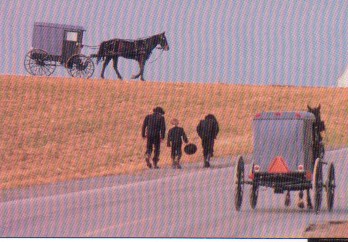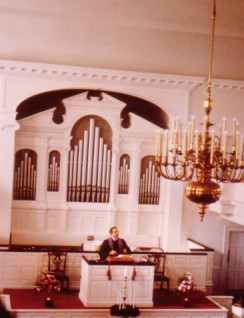|
● Religious
Liberty
● Protestants
in the United States
● CathoLics
● Three
Faiths
● Religious
Diversity
● American
Character of Religion
Religious Diversity
 |
|
Amish
People in Pennsylvania
|
 The
United States has always been a fertile ground for the growth of
new religious movements. Frontier America provided plenty of room
to set up a new church or found a new community. For example, the
ancestors of the Amish,
very strict Protestants who live in rural areas and scorn modern
life, came from Germany in the 18th century to escape persecution. The
United States has always been a fertile ground for the growth of
new religious movements. Frontier America provided plenty of room
to set up a new church or found a new community. For example, the
ancestors of the Amish,
very strict Protestants who live in rural areas and scorn modern
life, came from Germany in the 18th century to escape persecution.
 Many
religious communities and secular utopias, or experiments in new
forms of social living, were founded in 18th and 19th century America.
Most did not last long. But some prospered for a while and a few
are still in existence. 20th-century
Americans who follow the impulse
to
withdraw
from
society and "join a commune"
are
following in an old American tradition. Many
religious communities and secular utopias, or experiments in new
forms of social living, were founded in 18th and 19th century America.
Most did not last long. But some prospered for a while and a few
are still in existence. 20th-century
Americans who follow the impulse
to
withdraw
from
society and "join a commune"
are
following in an old American tradition.
 Small
sects and "cults"
do have certain tendencies in common. Often they regard the larger
society as hopelessly corrupt. Prohibition of alcohol, tobacco and
caffeine
are common. Sometimes
dramatic expectations about the future—predictions of the end of
the world or the dawning
of
a new age—form the main tenets, or doctrines, of the group.
Often the founder is a charismatic
person, dynamic
personality who claims some special revelation
or relationship with God. Some groups never win a large following.
Others grow smaller or disappear when the founder dies or his prophecies
fail to come true. Still
others prosper, win large followings and “graduate” into the ranks
of the "respectable" denominations. Small
sects and "cults"
do have certain tendencies in common. Often they regard the larger
society as hopelessly corrupt. Prohibition of alcohol, tobacco and
caffeine
are common. Sometimes
dramatic expectations about the future—predictions of the end of
the world or the dawning
of
a new age—form the main tenets, or doctrines, of the group.
Often the founder is a charismatic
person, dynamic
personality who claims some special revelation
or relationship with God. Some groups never win a large following.
Others grow smaller or disappear when the founder dies or his prophecies
fail to come true. Still
others prosper, win large followings and “graduate” into the ranks
of the "respectable" denominations.
 Some
groups, like the Amish of Pennsylvania, simply want to be left alone
in their rural communities. They wish to keep their children out of
high school so they will not be affected by modern society. Some
groups, like the Amish of Pennsylvania, simply want to be left alone
in their rural communities. They wish to keep their children out of
high school so they will not be affected by modern society.
 A
few prefer faith healing to modern medicine or object to certain medical
practices. What should society do when a Jehovah's
Witness refused a blood transfusion for himself or his child? A
few prefer faith healing to modern medicine or object to certain medical
practices. What should society do when a Jehovah's
Witness refused a blood transfusion for himself or his child?
 |
|
A
Mormon Temple in the Great Salt Lake City
|
 Questions
like these often come before the courts in the United States. They
are generally settled according to a principle the Supreme Court
established when it ruled that the Mormons,
a large and prosperous Christian sect that settled the state of
Utah, could not marry more than one wife. Individuals may
believe anything they please in America, but they may not do anything
they want, even if the action is based on a religious belief. Such
questions do not usually cause great controversy, because they do
not reflect basic divisions in American society. The Mormons, for
example, continue to flourish, and are one of the fastest growing
church groups in the United States. Questions
like these often come before the courts in the United States. They
are generally settled according to a principle the Supreme Court
established when it ruled that the Mormons,
a large and prosperous Christian sect that settled the state of
Utah, could not marry more than one wife. Individuals may
believe anything they please in America, but they may not do anything
they want, even if the action is based on a religious belief. Such
questions do not usually cause great controversy, because they do
not reflect basic divisions in American society. The Mormons, for
example, continue to flourish, and are one of the fastest growing
church groups in the United States.
 But
other questions reflect continuing conflicts in American life. When
a 1973 Supreme Court decision made abortion
legal in America, many Catholics were shocked. Many evangelical
Protestants and Orthodox
Jews also objected. Yet more liberal Protestant and Jewish
clergymen
joined nonbelievers in maintaining that abortion is a basic right
in a pluralistic,
or religiously varied, society. But
other questions reflect continuing conflicts in American life. When
a 1973 Supreme Court decision made abortion
legal in America, many Catholics were shocked. Many evangelical
Protestants and Orthodox
Jews also objected. Yet more liberal Protestant and Jewish
clergymen
joined nonbelievers in maintaining that abortion is a basic right
in a pluralistic,
or religiously varied, society.
 Other
world religions are increasing their numbers and influence in America.
Over 2 million members of the Islamic religion live in America.Some
are immigrants or the children of immigrants; others are Americans,
including some black Americans who have converted to Islam. Other
world religions are increasing their numbers and influence in America.
Over 2 million members of the Islamic religion live in America.Some
are immigrants or the children of immigrants; others are Americans,
including some black Americans who have converted to Islam.
|
|
|
Praying
Outside a Mosque in New Mexico
|
|
|
|
A
Buddhist Temple in Hawaii
|
 Buddhism
is a growing faith in America. Recent immigration from Asia
has raised the number of Buddhists
in America to several hundred thousand—no one seems quite sure
how many. Several hundred thousand Hindus
have also come to America. In recent years, young native-born Americans
have shown great interest in these and other eastern religions and
philosophies. Buddhism
is a growing faith in America. Recent immigration from Asia
has raised the number of Buddhists
in America to several hundred thousand—no one seems quite sure
how many. Several hundred thousand Hindus
have also come to America. In recent years, young native-born Americans
have shown great interest in these and other eastern religions and
philosophies.
|
|
|
Worship
in a Hindu Temple in New Jersey
|
|
|
|
An
Anglican Woman Priest
|
 American
pastors
are as varied as the flocks
they serve. Some of them are women. The Protestant Episcopal
Church now ordains
women as priests,although the Catholic Church continues to have
an all-male clergy. The United Methodist Church has appointed women
as bishops.
Women can also be ordained as rabbis
among some Jewish congregations. Catholic nuns
teach and manage large hospitals. Chaplains of all faiths visit
the sick in hospitals and nursing homes. American
pastors
are as varied as the flocks
they serve. Some of them are women. The Protestant Episcopal
Church now ordains
women as priests,although the Catholic Church continues to have
an all-male clergy. The United Methodist Church has appointed women
as bishops.
Women can also be ordained as rabbis
among some Jewish congregations. Catholic nuns
teach and manage large hospitals. Chaplains of all faiths visit
the sick in hospitals and nursing homes.
 American
pastors of churches are expected to be active in the civic affairs
of their communities. Often they have psychological training and
spend part of their time counseling
people with personal problems. They preach to congregations assembled
in small chapels
and huge city cathedrals,
in modern synagogues,
and even sometimes in drive-in churches where people can worship without leaving their
cars! Some evangelical preachers reach a television audience of
millions. American
pastors of churches are expected to be active in the civic affairs
of their communities. Often they have psychological training and
spend part of their time counseling
people with personal problems. They preach to congregations assembled
in small chapels
and huge city cathedrals,
in modern synagogues,
and even sometimes in drive-in churches where people can worship without leaving their
cars! Some evangelical preachers reach a television audience of
millions.
|
|
 |
|
Princeton
University Chapel
|
Preaching
in a First Congregational Church, New England
|
 How
do Americans of so many different religions manage to live together
under common laws and pursue common goals? The answers can be found
in the American character of religion. How
do Americans of so many different religions manage to live together
under common laws and pursue common goals? The answers can be found
in the American character of religion.
Previous Page Next
Page
|

